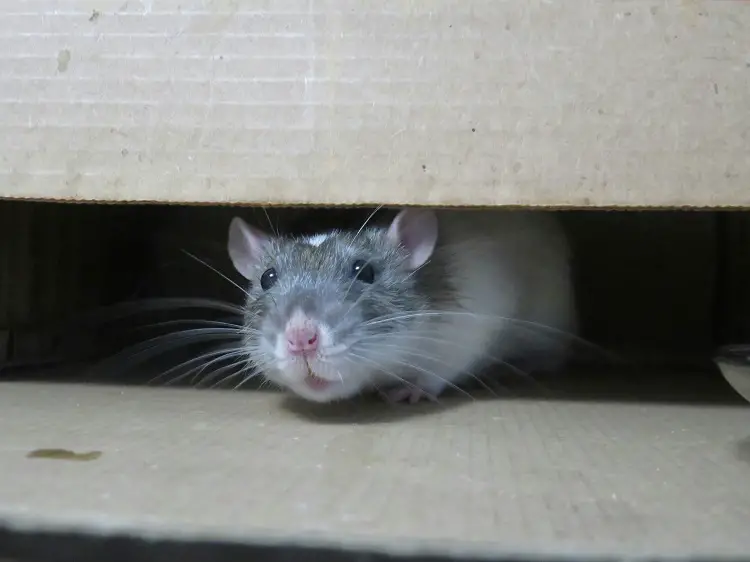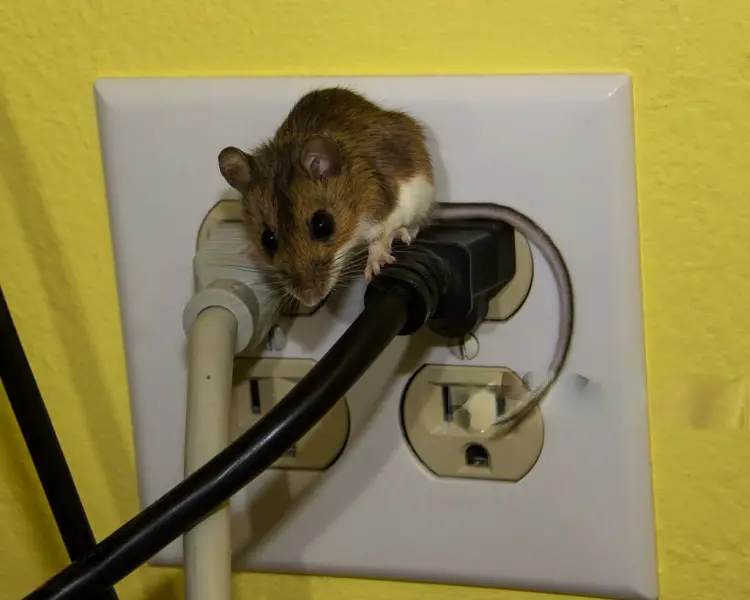Are you surprised at the sight of mice in your upstairs apartment? Are you shocked that those small creatures find their way to your upstairs apartment?
Mice infestations in apartments can be a significant problem, and understanding how mice gain entry to upstairs apartments is crucial for effective prevention and control.
These opportunistic creatures can squeeze through tiny openings, and their agility enables them to navigate various spaces most people wouldn’t expect.
This article aims to provide a detailed overview of how mice can infiltrate upstairs apartments, explain how mice gain entry to upstairs apartments, and outline practical steps you can take to prevent their entry.
How to Identify a Mouse Problem in Your Apartment
If you want to make your home from mice habitation, the first step in ridding your home of a mouse is to identify its presence. The following signs are evidence of the presence of mice in your home:
Droppings
Mouse droppings are one of the most obvious signs of a mouse problem in your apartment.
Look around your house for the presence of feces from mice, and I am pretty sure that you will see them as they are small, dark in color, and have a granular shape.
It is not advisable to allow the mouse droppings in your home to continue because
They can harbor dangerous pathogens, as a result, you must collect and dispose of them safely is important.
Noises
Mice make scratching sounds with their feet when they move around and squeaking noises with their mouths. Their noises are mostly noticed at night because they are mostly night or nocturnal animals.
Foul Odor
Another way to detect the presence of mice in your upstairs apartment is through their odor, because they have a very strong odor. The odor is slightly musky and will be strongest in the areas where they congregate most.
Gnaw Marks
Mice always leave bite marks on any item in your apartment. Though you’ll see them more commonly on food or items used as a nesting material.
Why Do Mice Target Upstairs Apartments?
It might seem unusual to find mice in an upstairs apartment, but these resourceful rodents are surprisingly adaptable. While most people assume mice only inhabit basements, ground floors, or outdoor areas, the truth is that upstairs units can be just as vulnerable — sometimes even more so. Here’s why:
1. Easy Access Through Building Structures
Mice are excellent climbers and can scale walls, pipes, electrical conduits, and even cable wires running along a building. In multi-unit apartment buildings, interconnected crawl spaces, ductwork, and utility shafts make it easy for them to travel vertically from lower units to upper floors without being noticed.
2. Food and Shelter Availability
If your apartment provides a reliable food source — whether from improperly stored pantry items, trash, or crumbs — mice won’t hesitate to make their way upstairs. They’re driven by instinct to seek out warmth, shelter, and sustenance, and upstairs units often offer quiet, undisturbed hiding spots away from heavy foot traffic.
3. Seasonal Weather Changes
During colder months, mice actively search for warm indoor environments. Upper-floor apartments often maintain more stable, warmer temperatures than ground-level units, making them attractive nesting spots when temperatures drop.
4. Existing Infestations in Neighboring Units
In multi-unit buildings, one infestation can quickly spread. If a downstairs or neighboring unit has a mice problem, it’s only a matter of time before the rodents travel upward through shared walls, ceilings, and utility access points in search of new shelter and food sources.
5. Overlooked Entry Points
Upstairs apartments often have overlooked vulnerabilities such as vents, air conditioning units, poorly sealed windows, or gaps around plumbing and electrical wiring. Mice only need a hole the size of a dime to squeeze through, and these small openings are often easier to miss in upper units.
Generally, mice target upstairs apartments for the same reasons they invade any living space — food, warmth, and shelter.
The structure of apartment buildings, combined with easy vertical access and overlooked entry points, makes upper-floor units just as susceptible to infestations as those on the ground level.
How Mice Gain Entry to Upstairs Apartments

Mice can access upstairs apartments through a variety of entry points, including:
1. Vents and Ducts
Mice can exploit gaps or openings in ventilation systems or ductwork. Regular maintenance and sealing of these openings with appropriate materials can prevent mice from using them as access points.
2. Cracks and Holes
Cracks and holes are wonderful ways these tiny creatures can find themselves in your upstairs apartment. If you want to prevent it, then you have to conduct a thorough inspection of walls, ceilings, and floors for any cracks, crevices, or holes. Seal these openings with caulk or steel wool to deny entry to mice.
3. Pipes and Wiring
Pipes and wiring are ways in which mice can find themselves in your upstairs apartment, and if you want to stop them from finding their way to your upstairs apartment, then you have to ensure that all openings around pipes, utility conduits, or electrical wiring are tightly sealed.
Using sealants and expanding foam can be effective in blocking these potential entry points.
4. Windows and Doors
Another point of entrance is the windows and the door, and if you want to prevent this from happening, then you have to just install door sweeps and weather stripping around doors and windows to eliminate gaps that mice could exploit. Regularly inspect and repair any damage to these entry points.
5. Attics and Crawlspaces
If the building has shared attics or crawlspaces, ensure these spaces are adequately sealed and maintained. Consider installing wire mesh or screens to prevent mice from entering common areas.
Things You Must Do When Trying to Combat a Mice Infestation
1. Check Pipes and Utility Lines
In trying to manage mice infestation then you have to deter mice from climbing pipes and utility lines, use materials like metal or plastic sleeves to cover them, making it difficult for mice to gain traction.
2. Vegetation
Ensure that you always trim branches and foliage that provide a pathway for mice to access upper floors. Ensure that trees and bushes are maintained at a safe distance from the building.
3. Check Building Features
Consider installing rodent deterrents such as metal barriers or mesh on ledges, balconies, or architectural features to prevent mice from using them as climbing aids.
Adaptability and Behavior of Mice that you should watch out for when trying
to manage mice infestation
Squeezing Through Small Spaces
Recognize that mice can exploit incredibly small openings. Be vigilant in sealing even the tiniest gaps to minimize the risk of mouse infestation.
Nocturnal Behavior
Given their nocturnal habits, set traps or baits during the night when mice are most active. Regularly check and reset traps to ensure effectiveness.
Curiosity and Exploratory Nature
Place deterrents like peppermint oil or ammonia near potential entry points. Mice dislike these smells and may be deterred from investigating further.
Preventive Measures
1. Sealing Every Entry Points
Conduct routine inspections, especially during seasonal changes, and promptly seal any new or existing entry points. Use appropriate materials such as silicone sealant, steel wool, or mesh.
2. Maintaining the Exterior
Keep the building exterior well-maintained by trimming vegetation, sealing cracks, and repairing any damages to the structure that could provide entry for mice.
3. Maintain a Good Proper Waste Management
Store garbage in sealed containers and dispose of it regularly. Clean up spills and crumbs to minimize food sources that attract mice.
4. Consult a Professional Pest Control
Consult a professional pest control service for regular inspections and customized preventive measures to address any existing infestations and prevent future ones effectively.
By implementing these comprehensive preventive measures and understanding the tactics mice use to infiltrate apartments, residents can significantly reduce the risk of mouse infestations in upstairs units. Vigilance and proactive action are key to maintaining a mouse-free living environment.
Read Also: How To Get Rid of Wasps
Takeaway
Mitigating the risk of mice infiltrating upstairs apartments requires a proactive and comprehensive approach. Understanding the numerous entry points, climbing abilities, adaptability, and behavior of mice is paramount.
By identifying and fortifying these vulnerabilities, residents can effectively prevent mouse infestations.
Sealing all potential entry points, maintaining the building’s exterior, and practicing proper waste management are critical steps in achieving a mouse-free living environment.

